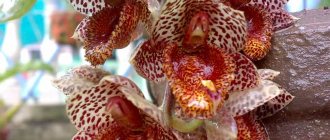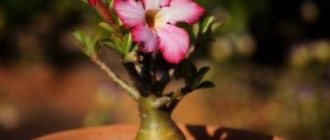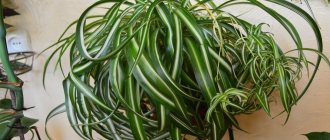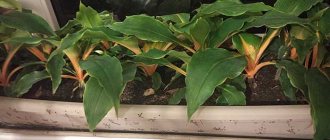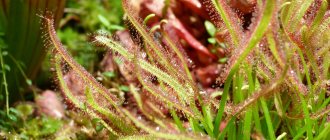Chlorophytum comosum Vittatum
Chlorophytums can often be seen in different interiors as potted, hanging plants, or in compositions with other plants. Chlorophytum crested is perhaps the most popular plant in the world. It looks especially beautiful on stands, where its fountain-shaped foliage and long flower shoots with daughter rosettes are clearly visible, for which it received the name Spider Plant. Its variegated forms are most often grown.
In addition to this species, prostrate chlorophytum with variegated foliage and orange chlorophytum with bright leaf petioles have become popular.
About cultivated species - on the Chlorophytum page.
Chlorophytum is recognized as one of the best plants for improving indoor air quality. It has one of the highest rates of formaldehyde absorption from the air.
This is an easy to grow plant that can be recommended to beginning gardeners. With good care, the plant can live for decades and grow quickly. It is easy to care for, tolerates average indoor conditions and reproduces easily.
Soil . A commercially available universal soil for indoor plants or a soil for decorative foliage plants is quite suitable for the plant. Both of them meet the necessary requirements - loose, suitable for chlorophytum in terms of acidity, close to neutral. You can make a substrate with the following composition: turf soil: leaf soil: sand (1: 3: 1). It is useful to add chopped sphagnum moss to the soil.
Replanting is required for young plants annually, for adults - every 2-3 years. The optimal time for transplantation is at the end of winter - beginning of spring. The root system of chlorophytum grows strongly, so a wide container is selected for it, 4-6 cm larger than the root ball. If there are a lot of tuberous thickenings on the roots that form due to insufficient watering, it is worthwhile to arrange regular watering. Good drainage must also be ensured.
If the roots emerge from the substrate on the surface, appear from the drainage hole, or burst or even damage the pot, replanting can be done at any time of the year.
Chlorophytum laxum
Lighting . Chlorophytum tolerates both direct sunlight for several hours a day and a shaded location equally well. Variegated forms require higher illumination; with a lack of light, the leaves lose their bright color.
Chlorophytum needs bright indirect light. The best placement option is windows facing east and west, where the sun hits the plant in the morning or evening. On southern windows on hot days, shading from the scorching rays of the sun is necessary to avoid burns. In the shade, chlorophytum grows more slowly and becomes pale.
Temperature . This plant is tolerant to a wide range of temperatures, from +10 to +27… +30℃. It is best to maintain a constant temperature in the spring-summer period within +18… +24℃. In summer, chlorophytum can be taken out into the open air - onto a terrace, balcony, or into the garden, but the plant should not be constantly exposed to the sun. In the autumn-winter period, the temperature is reduced to +14... +20℃, but is not allowed to drop below +10℃ - this limit is critical for chlorophytum.
The plant needs abundant watering If there is a lack of water, numerous tuberous thickenings form on the roots, serving to store moisture, which allows the plant to survive drying out of the soil. However, it should not be repeated. It is necessary to ensure that the soil dries to a depth of no more than 5 cm. Over-moistening should also be avoided - excess water flowing into the pan must be drained. In the autumn-winter period, the volume of watering is reduced, but the substrate is not allowed to dry out between waterings.
Chlorophytum should be watered with soft water, because... Hard water causes brown spots to appear on leaves.
Air humidity is not a necessary factor in growing a plant; chlorophytum tolerates dry air well. However, a humidity level of 50-70% is still desirable. Dry leaf tips indicate dry air. Regular spraying in the summer improves the appearance of the plant.
Chlorophytum orange Green Orange
Fertilizing is applied regularly from March to September, 2 times a month, using organo-mineral fertilizer for decorative deciduous plants, diluted by half. Chlorophytum responds to feeding with active growth, especially in spring. Young plants that are annually transplanted into fresh soil do not need to be fed.
The rest period is organized from October to January due to reduced natural light. The temperature is reduced to +12… +18℃. Water regularly, avoiding drying out the substrate. No fertilizing is applied.
Bloom . Chlorophytums bloom in summer. Flowering may not occur in young plants. Specimens in a cramped pot do not bloom. Overfed chlorophytums, which produce large leaf mass to the detriment of flowering, bloom poorly.
Trimming . Chlorophytum orange is sometimes propagated by seeds, and they can be obtained indoors. But if the task of obtaining seeds is not necessary, the flowering stem is cut off, which increases the decorativeness of the leaf rosette.
Pests are rarely found on chlorophytums. Sometimes weakened plants are affected by aphids, mealybugs, spider mites, and whiteflies.
Chlorophytum crested magically attracts cats, which eat the tips of the shoots, so it is advisable to place the plant in a place inaccessible to animals.
History of the Latin name of the plant
Chlorophytum adapts perfectly to almost any environment. It has several features that allowed it to quickly spread throughout tropical America:
- unpretentiousness;
- fast growth;
- the ability to be in the ground and in the water.
Reference .
Scientists still do not agree on which family this culture belongs to. Some classify it as a lily for its ability to grow in water, but others find many similarities with aspholedaceae. The name itself can be translated as “green plant”. However, chlorophytum also has several unofficial definitions - spider and green lily. This family numbers more than 200 species. Each of them has its own characteristics. However, due to their common characteristics, they are classified as one family.
Reproduction by children
As I already wrote above, Chlorophytum crested has many hanging babies that are immediately ready for independent existence.
Then we immediately prepare the soil mixture (leaf soil, turf, humus, peat or sand). We put drainage at the bottom of the pot. We moisten the soil and plant it in a hole.
It is correct to propagate a flower 4-5 years old, in the warm season.
We will learn more about this method in more detail and clearly from the video.
Origin and homeland of the green flower
South and Central America are considered the homeland of this plant. It can also be seen in the northern part of the American continent, but it prefers chlorophytum to the tropics. Unlike a number of other crops, it can grow simultaneously in water and dry soil, which significantly expands its distribution area.
Scientists managed to domesticate this flower quite quickly, as a result of which it spread to all continents except Antarctica. In its natural environment it can be seen in the following areas:
- Central and South America;
- South-East Asia;
- Indonesia.
This became possible only thanks to the domestication of the flower and its further cultivation in a new territory for it. It took root quite quickly and is now growing well in the proposed conditions.
What does simple chlorophytum look like?
It is necessary to understand exactly what simple chlorophytum looks like. It is believed that all other varieties and varieties came from it. Let's take a closer look at the appearance of this plant.
Appearance
This is a herbaceous evergreen plant, which has a large number of subspecies. Given their diversity, it is not always possible to identify a culture.
Here are the main features:
- the stem is shortened. A large number of leaves grow from it;
- The bush itself is small. Usually does not exceed 60 cm in diameter with about the same in height;
- leaves are evergreen, elongated, reduced type;
- there may be small white flowers in the form of stars;
- after the end of flowering, numerous daughter plants are formed, each of them has its own root system.
Reference . Today there is one- and two-tier chlorophytum. Very rarely in nature you can find a third tier. However, for a small stem it is very difficult to hold. There are bushy and tree-like varieties. The latter have a thick stem, which can have up to five tiers at a time.
Blooming chlorophytum with photo
This plant can bloom quite profusely. But this requires achieving ideal conditions. If they do not meet the requirements, then the bush remains evergreen.
For flowering you need to provide the following:
- timely watering;
- correct transplantation;
- feeding;
- temperature regime;
- air humidity.
Under favorable conditions, several flowers appear on the plant. After this, new plants are obtained from them. Thus, Chlorophytum reproduces through flowering. If conditions are not optimal, then it will grow without producing offspring. But this does not mean that you cannot get another plant. More details about reproduction methods will be written below.
Description of the structure
To briefly describe this culture, we can identify the following:
- leaves are collected in a rosette;
- stem shortened;
- type of leaf attachment - sessile;
- the shape of the plate is linear, the upper part is pointed or elongated;
- The leaf is simple, without branches, with parallel veins, entire.
Important! This description is only suitable for Chlorophytum vulgaris. Other varieties may differ significantly from it in appearance.
Root system
This plant grows quite quickly thanks to its developed root system. It differs as follows:
- yellowish color;
- branched roots;
- They quickly take up the entire pot.
The roots absorb nutrients in the soil well. Since they grow quickly, it is necessary to replant the plant in a timely manner. Otherwise, the pot may burst. It is also recommended to fertilize regularly. This will speed up growth and make flowering more abundant.
Planting chlorophytum
It is necessary to plant chlorophytum correctly so that it feels normal and grows quickly. Experienced florists say that the correct technique determines how quickly the flower adapts to new conditions and continues to grow. Therefore, do not underestimate the importance of correctly planting and replanting chlorophytum. It’s worth taking a closer look at exactly how to do everything and in what order.
Preparation
Before planting chlorophytum, you need to perform several steps. In particular, it is required:
- buy a suitable pot, which will be made of plastic or clay;
- purchase special soil or make it yourself;
- take planting material.
Reference . There are special requirements for the soil. It must have neutral acidity. Suitable universal soil for indoor flowers. Many florists prefer soil intended for deciduous plants. Culture feels good in it. However, it is additionally required to add humus and sand. The finished soil should allow water to pass through perfectly. Therefore, it is recommended to periodically weed after watering.
How to plant a flower at home?
The planting process is standard. It requires following a certain algorithm, namely:
- a drainage layer is formed in the pot;
- then the substrate is poured;
- the baby is separated from the main bush;
- planted in a pot;
- the root system is sprinkled with earth;
- watering is carried out.
Important! The plant loves abundant watering, but it is forbidden to overwater it. The top layer of soil should always be moist. Therefore, you need to moisturize it in a timely manner. You can also lay moss on top to protect the soil from drying out quickly.
How to grow chlorophytum at home?
You need to know how to properly grow a plant so that it feels great and blooms profusely. There are several recommendations from experienced florists. By following them, you can ensure rapid growth.
Temperature
This flower is considered unpretentious. It adapts perfectly to almost any conditions.
Here are some recommendations:
- the upper limit of the temperature regime is 27 degrees;
- lower limit - 18 degrees;
- changes of more than 5 degrees are undesirable.
Reference . The flower doesn't really like it when the wind blows around the room. There is a risk that the leaves will turn yellow and gradually wither.
Lighting
It is very important that the plant is comfortable. To do this, you need to provide proper lighting. The flower loves light, but is afraid of direct sunlight. Burns appear almost immediately. Therefore, diffused light is recommended.
Recommendations for choosing a location:
- it is better to place it in the kitchen, since chlorophytum loves a large amount of carbon dioxide;
- It is recommended to install not on a windowsill, but in a place with sufficient light;
- if there is not enough sun, the leaves begin to fade and growth slows down.
All this is important to consider when choosing a place for a flower.
Watering
It is very important to water this crop correctly. Here are some rules:
- The plant is moisture-loving, so it is better to overwater than underwater.
- The top layer of soil should be kept moist at all times.
- Frequent overwatering is harmful to the culture. In this case, the roots begin to rot.
- If for some reason the soil is dry, place the plant in a sink with water for about an hour so that moisture is constantly in the pan.
- When watering, it is necessary to supply water through the pan and from above.
- Periodic spraying of the crop with a spray bottle is highly recommended.
Reference . To make the plant feel better, use rain or settled water.
If watering is very abundant for a long time, the roots begin to rot. In this case, you need to urgently replant the flower. In this case, it is necessary to remove the rot and use a new substrate. Before transplanting, but after the flower is pulled out of the ground, the roots are dried for 3-5 hours. After this, the crop can be planted in a new pot.
Air humidity
Considering how much the culture loves water, it is logical to assume that it needs high air humidity. This is true. The optimal indicator is 80-90% . If the parameter becomes about 65%, then chlorophytum begins to slowly dry out. It needs more abundant watering.
To eliminate growth problems, experienced gardeners install a humidifier in the room with plants. However, not everyone can afford it for various reasons. There is a cheaper solution to the problem. It is enough to place a container of water next to the pot.
Top dressing
It is important to periodically feed this plant. If there are enough nutrients, it will grow faster. However, we must remember that excessive feeding kills the crop.
Here are the basic rules for feeding:
- Fertilizers should be applied from spring to autumn.
- It is necessary to use complex or universal compositions for indoor flowers. They should contain potassium, magnesium, phosphorus and superphosphate.
- You can make fertilizers yourself. For example, from banana peels, which are infused in one liter of water.
- The frequency of feeding is 2 times a month.
Reference . If a flower reacts poorly to feeding, then fertilizer is not suitable for it. You shouldn't continue to use it. It's better to try something else. You can find out which one is suitable only experimentally, taking into account the number of subspecies of chlorophytum. However, as practice shows, problems do not arise when using universal fertilizers.
When performing proper watering, not everyone remembers the need to apply fertilizer. In this case, it is impossible to achieve rapid growth and abundant flowering. Over time, the soil becomes depleted. Then the flower feels bad. It may die if a pot is purchased “for growth.” However, if you choose the right container, there are no problems. The soil changes every year. If it's from a store, it's fortified with nutrients. They are just enough for about 12 months.
Transplantation and how to plant?
It is necessary to replant the plant every year. The fact is that the root system grows quite quickly and becomes crowded. However, the new pot should not be too spacious. It is recommended that it be 2-3 cm larger than the previous one.
Plant transplantation process:
- In spring a new pot is prepared. If you have children and plan to plant them out, you will need several pots.
- Then separate the rosettes from the main chlorophytum using a sharp knife.
- First, the children are planted according to the boarding algorithm.
- Then you need to pull out the main plant and clean its roots from the substrate.
- Afterwards you need to inspect whether there is rot on the roots. If present, it is removed.
- Next, you need to plant the flower in a new pot and sprinkle it with soil.
Important . It is highly recommended to use store-bought soil. It is already enriched with nutrients and is completely suitable for chlorophytum. It is also disinfected, so there is no risk of pests.
If a flower is sick, you need to act quickly. He does not have a very strong immune system, which does not allow him to experiment. It is best to use fungicides. Industrial pesticides are used against pests.
When does flowering begin?
Flowering can only be achieved under the following factors:
- optimal conditions of detention;
- timely pruning;
- periodic feeding.
Flowering usually occurs from spring to autumn . In winter, the plant is dormant. Thus, you can see flowers only in the warm season, but for this you need to ensure that the culture is happy indoors. The flowering itself lasts about one month.
Root care
The root system does not require special care. However, several important factors must be taken into account, namely:
- replanting a flower every year;
- if there is rot, it is necessary to cut off damaged roots;
- if the bush is divided, then the cut site must be treated with antiseptics;
- When replanting, you need to be careful and carefully clean the root system from the substrate.
These are the main nuances that you need to remember when taking care of the root system. It is not recommended to add organic fertilizers. They will burn the roots and the flower will die. If there is a strong desire to use them, then the dosage should be small, and fertilizing should be done exclusively in liquid form.
Brief description of cultivation
- Bloom . Chlorophytum is grown as an ornamental foliage plant.
- Illumination . You need bright light, which should be diffused. Variegated varieties need brighter light, while green-leaved forms can be grown in partial shade.
- Temperature regime . Grows well at normal room temperature. Make sure that in winter the air temperature in the room is not below 10 degrees.
- Watering . In spring and autumn, you need to water the flower systematically and abundantly. During the winter months, reduced watering is required. At this time, watering is carried out only when the soil mixture dries out to ¼ of the depth.
- Air humidity . Typical for a living room.
- Fertilizer . The plant is fed only in the spring-summer period once every half month; for this purpose, organic matter and mineral fertilizers are used alternately.
- Rest period . In October–January.
- Transplant . In the last winter or first spring weeks. While the bush is young, it is replanted every year, older specimens - once every 2 or 3 years.
- Soil mixture . Its composition should include sand, turf, humus and leaf soil (1: 2: 2: 2).
- Reproduction . By layering and seed method.
- Harmful insects . Mealybugs, aphids and spider mites.
- Diseases . With improper care, rot may develop on the rosette of leaves, and spots may also appear on the leaf blades, the pattern disappears in variegated forms, and the foliage may also lose turgor.
Chlorophytum - growing and care. Healthy in your home!!!
How to use chlorophytum in the interior of an apartment?
This culture is often used to make an apartment more attractive. The flower also has many positive properties. It is worth considering all these nuances in more detail.
Benefits for the home
Chlorophytum is often grown by florists at home. Moreover, you can often find several species at once in one apartment. Diversity allows you to create original interiors. When the babies hang from the main bush, it looks very beautiful. The same applies to crested chlorophytums. Orange ones are much less common.
Regardless of the type of flower, it has many useful properties, these include the following:
- Purifying the air from harmful impurities and toxins.
- The plant is quite beautiful and decorates the interior.
- Indoor air humidification.
- Prevention of colds.
- Reducing the risk of developing allergies. If it exists, then its negative impact is suppressed.
This flower is often bred not only for its decorative qualities, but also for its beneficial properties. However, it is worth setting it higher if there are small children in the apartment. The fact is that its juice is poisonous to humans: if a baby bites a leaf, it can be poisoned.
Today chlorophytum can be seen in many institutions and apartments. The plant is unpretentious. The number of species is amazing, and new ones appear periodically. But this is already the result of the work of breeders. It is not difficult to propagate this crop, since after flowering a new flower always appears. Thus, this is an excellent opportunity for novice florists to practice growing indoor flowers.
Photo
The following photo shows the Chlorophytum flower:
Look further at the photo of indoor flowers Chlorophytum:

